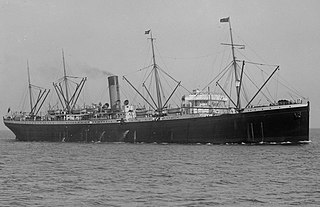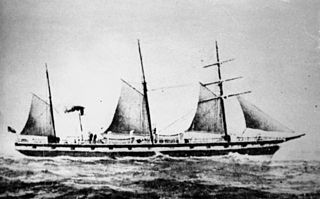
Kangaroo Island, also known as Karta Pintingga, is Australia's third-largest island, after Tasmania and Melville Island. It lies in the state of South Australia, 112 km (70 mi) southwest of Adelaide. Its closest point to the mainland is Snapper Point in Backstairs Passage, which is 13.5 km (8.4 mi) from the Fleurieu Peninsula.

MS Mikhail Lermontov was an ocean liner owned by the Soviet Union's Baltic Shipping Company, built in 1972 by V.E.B. Mathias-Thesen Werft, Wismar, East Germany. It was later converted into a cruise ship. On 16 February 1986 it collided with rocks near Port Gore in the Marlborough Sounds, New Zealand, and sank, claiming the life of one of its crew members.

Marco Polo was a three-masted wooden clipper ship, launched in 1851 at Saint John, New Brunswick. She was named after Venetian traveler Marco Polo. The ship carried emigrants and passengers to Australia and was the first vessel to make the round trip from Liverpool in under six months. Later in her career, the ship was used as a cargo ship before running aground off Cavendish, Prince Edward Island, in 1883.

Loch Ard was a clipper which was wrecked in the bight between Moonlight Head and Port Campbell, just off the Shipwreck Coast of Victoria, Australia in 1878. The name was drawn from Loch Ard, a loch which lies to the west of Aberfoyle, and to the east of Loch Lomond. It means "high lake" in Scottish Gaelic.
Cape du Couedic is a headland in the Australian state of South Australia located on the southwest tip of Kangaroo Island in the locality of Flinders Chase. It was named after a French naval officer, Charles Louis du Couëdic de Kergoualer, by the Baudin expedition to Australia during January 1803. It is the site for the Cape du Couedic Lighthouse. It is currently located within the Flinders Chase National Park.
Neva was a three-masted barque launched in 1813. She made two voyages transporting convicts to Australia. On her second voyage carrying convicts she wrecked in Bass Strait on 13 May 1835. Her loss was one of the worst shipwrecks in Australian history; 224 lives were lost.

SS Suevic was a steamship built by Harland and Wolff in Belfast for the White Star Line. Suevic was the fifth and last of the Jubilee-class ocean liners, built specifically to service the Liverpool-Cape Town-Sydney route, along with her sister ship Runic. In 1907 she was wrecked off the south coast of England, but in the largest rescue of its kind, all passengers and crew were saved. The ship herself was deliberately broken in two, and a new bow was attached to the salvaged stern portion. Later serving as a Norwegian whaling factory ship carrying the name Skytteren, she was scuttled off the Swedish coast in 1942 to prevent her capture by ships of Nazi Germany.
Union was constructed at Barnstable, Massachusetts, later purchased by Edmund Fanning, who refitted and registered the vessel in New York under ownership of Fanning & Coles shipping company partnership.

The SS Gothenburg was a steamship that operated along the British and then later the Australian and New Zealand coastlines. In February 1875, Gothenburg left Darwin, Australia and while en route to Adelaide it encountered a cyclone-strength storm off the north Queensland coast. The ship was wrecked on the Great Barrier Reef north-west of Holbourne Island on 24 February 1875. Survivors in one of the lifeboats were rescued two days later by Leichhardt, while the occupants of two other lifeboats that managed to reach Holbourne Island were rescued several days later. Twenty-two men survived, while between 98 and 112 others died, including a number of high-profile civil servants and dignitaries.

Loch Vennachar was a three-masted iron sailing ship (clipper) that operated between Great Britain and Australia between the late 19th century and 1905. The name was drawn from Loch Venachar, a loch which lies to the south-west of the burgh of Callander, in the Stirling region of Scotland. It is understood to mean "most beautiful lady" in Scottish Gaelic.
The Loch Line of Glasgow, Scotland, was a group of ill-fated colonial clippers managed by Messrs William Aitken and James Lilburn, whose sailing ships plied between the United Kingdom and Australia from 1867 to 1911.

The SSCity of Boston was a British iron-hulled single-screw passenger steamship of the Inman Line which disappeared in the North Atlantic Ocean en route from Halifax, Nova Scotia, to Liverpool in January 1870.

The wreck of the Grosvenor, an East Indiaman, occurred on 4 August 1782 on the Pondoland coast of South Africa, north of the mouth of the Umzimvubu River. The shipwreck was close to the place where the Portuguese ship, São João, had gone down more than two centuries earlier on 8 June 1552. The Grosvenor was a three-masted ship of 729 tons on her return voyage to England when she was wrecked, carrying a crew of 132 and 18 passengers, and a cargo valued at £75,000. Of the 123 survivors, only 18 reached Cape Town and were repatriated, the remainder dying of their privations or joining with, [[Southern Bantu natives] tribes. Four survivors, Robert Price, Thomas Lewis, John Warmington, and Barney Larey, eventually got back to England.

John Finlay Duff was a ship's captain and businessman in the Colony of South Australia.

The SS Taiaroa was 228 ton Union Steam ship coaster that grounded near the Waiau Toa / Clarence River on 11 April 1886. Thirty six people, 15 passengers and 21 crew, total lost their lives when they abandoned the boat after it had grounded.
Maupertuis Bay is a bay in the Australian state of South Australia located on the south-west coastline of Kangaroo Island.

Flinders Chase is a locality in the Australian state of South Australia located on the south-western coast of Kangaroo Island overlooking the body of water known in Australia as the Southern Ocean and by international authorities as the Great Australian Bight. It is located about 210 kilometres south-west of the state capital of Adelaide.

The SS Schomberg was a clipper built in Aberdeen by Alexander Hall & Co. for "the Black Ball line" for carrying large cargoes and steerage passengers, and to "outdo the Americans". When built, she was regarded as the most luxurious and well-built clipper of the period.

Langton Grange was a refrigerated steam cargo ship built in 1896 by the Workman, Clark & Co. of Belfast for Houlder Brothers & Co. of London to transport meat and other produce from Australia and South America to United Kingdom.
SS Melita was one of a pair of transatlantic steam ocean liners that were built in the United Kingdom, launched in 1917 and operated by Canadian Pacific until 1935. Her sister ship was Minnedosa.














